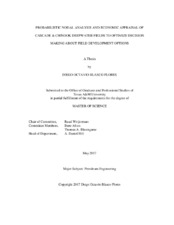| dc.description.abstract | This study provides an integrated technical and economic assessment of the Cascade and Chinook deepwater field development using Probabilistic Nodal Analysis (PNA), incorporating oil and gas price uncertainty to optimize decision making about field development options. The petroleum industry in North America has been focusing heavily on unconventional reservoirs, while deepwater reservoirs (Federal Offshore) account for 10% of gross oil production in the United States. This integrated approach will help determine the optimum field development options for an ultra-deepwater field in the Gulf of Mexico (GoM) including a sensitivity analysis accounting for future oil price uncertainty.
Unlike the traditional Arps Decline Curve Analysis (DCA), Probabilistic Nodal Analysis as a production forecasting method takes into account the reservoir properties, the production facilities and historic production data, while capturing the uncertainty of key parameters. PNA provides a range for the estimated ultimate recovery (EUR) from P10-P90, with the most likely value at P50. Assessing the possible outcomes increases the odds the optimal decision will be taken for a project, optimizing field development decisions including number of wells, the facilities to be used and whether the field should be produced under natural drive, artificial lift or waterflooding.
Economic analysis based on the probabilistic production curves, along with oil price sensitivity, will help determine the respective project’s minimum commodity price to be economically viable, which is essential since the volatility of oil prices may threaten profitability of offshore projects more than onshore projects. For the base case of $60/bbl, the P50 EUR for Cascade and Chinook increases by 42% and 45% respectively when using artificial lift compared to natural drive. Despite the increase in production, the P50-NPV@10 for Cascade and Chinook remains negative for the current development using a base case oil price of $60/bbl. Only with the addition of new wells using artificial lift in the Chinook field will the NPV@10 become positive at $146 million when produced with two wells, and $163 million by adding a third well, with the latter option having a higher risk; these are base case results for $60/bbl. In addition, project viability is assessed in a sensitivity analysis with oil prices ranging from $30 to $90. | en |


